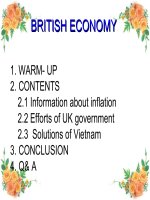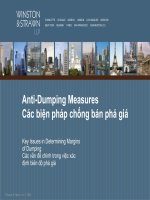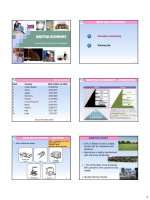Slide british economy edited 2014
Bạn đang xem bản rút gọn của tài liệu. Xem và tải ngay bản đầy đủ của tài liệu tại đây (1.78 MB, 30 trang )
BRITISH economy
By: Tra My – Thanh Thuy B
– Vu Doan Phuong Thao
1
Lead-in
Gross domestic
products
What does GDP mean?
What is the 2013 GDP of Vietnam?
A. 125.8 billion USD
B. 100.8 billion USD Worldbank.org
C. 171.4 billion USD
D. 165.8 billion USD
World rank: 57
Worldbank.org
2
LEAD-IN
GDP real growth rate
Year
5.2%
2010
5.4%
2011
6.2%
2012
6.4%
2013
3
Lead-in: vietnam gdp real
growth
2010: 6.4%
2011: 6.2%
2012: 5.2%
2013: 5.4%
4
What is the rank of the UK in terms of GDP?
6th
Which of the following numbers represents
the UK’s approximate 2013 GDP?
A. 2,461.77 billion of USD
B. 32,137 billion of USD
C. 232,137 billion of USD
D. 2,232,137 billion of USD
Source: Worldbank.org
5
Lead-in
Rank the following countries, which
are those with highest GDP, as listed
by the Worldbank in 2013
Russia
France
Japan
The U.K.
Brazil
China
Germany
India
The U.S.
6
Rank
Country
GDP (2013)
1
United States
16,800,000 mil
dollars
2
3
China
Japan
9,240,270
4,901,530
4
5
6
7
3,634,823
2,734,949
2,521,381
8
Russia Federation
9
Italy
10
India
Germany
France
United Kingdom
Brazil
2,245,673
2,096,777
2,071,307
1,876,797
Source:
Worldbank.org
7
A
Overview of economy
B
Working life
8
World
Economic
Overview
Europe
#6
Population: 63,612,729
GDP growth: 0%
Life expectancy: 82 years
9
Agriculture: 1%
Main industries today: Industry: 26%
Services: 73% (2008 est.)
Banking and finance
Steel
Oil and gas
Transport equipment
Tourism
10
Agriculture
25% of Britain's land is arable
50% land for meadows and
pastures.
Agriculture is highly mechanized
and extremely productive
2% of the labor force produces 60%
percent of the country's food needs
Sizable fishing industry
11
Industry
Export
• Manufactured
•
Raw materials
•
40% food supplies
goods
Import
12
Service
banking, insurance, business services
Dominated
service-related industries
3.5 million
manufacturing jobs
70s - 80s
service-related jobs
90s
3.5 million
13
Exports & imports
•
Exports
•
Imports
14
Trade Focus
15
Exports
Exports: $442.2 billion (2007)
Largest export earner: Chemical
Export Partners (2007)
US
15%
Germany
11%
France
10%
Ireland
7%
Netherlands
6%
Belgium
6%
Spain
5%
16
Imports
Imports: $621.4 billion (2007)
Import Partners (2007)
Germany
14.2%
US
8.6%
China
7.3%
Netherlands
7.3%
France
6.9%
Belgium
4.7%
Norway
4.7%
17
THE STRUCTURE OF TRADE
& INDUSTRY
Economic system: private + public
History:
1945-1980:
state controlled
1979- 1990
1980s:
Conservative government gave more freedom to
businessmen
Privatize companies (share holders)
1994:
most had been privatised
18
A
Overview of economy
B
Working life
19
ATTITUDE TO WORK
Lack of enthusiasm for work
+ Leisure = a sign of aristocracy
+ Non-manual job = sign of middle-class
+ Working day: starts late (8 a.m. for
manual jobs and 9 a.m. for non-manual
ones)
Industrious
High earnings are more important than
job satisfaction
Now, weaker connection between
20
middle class and non-manual work
SHOPPING AS A WAY OF
SPENDING MONEY
Not adventurous
shoppers (like
reliability + brandname goods)
Late 20th cent.: supermarkets moved out of
town
High streets (area in town where
shops concentrate) still survive
Shop opening hours: 9a.m. (On Sundays, large
21
shops + supermarkets: 6 hours)
Harrod’s, the most famous department store in England that all
visitors want to visit. Here you can find anything, from the cheapest
to the most expensive things
22
Tesco (Southport), one supermarket of the British largest
supermarket chain
23
/>
Not
only are we, in the words of
Napoleon, 'a nation of
shopkeepers', we are also a country
of compulsive shoppers. We love to
shop! It is our number one leisure
activity and accounts for around
37% of all money spent in England.
24
25









